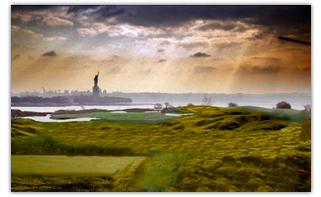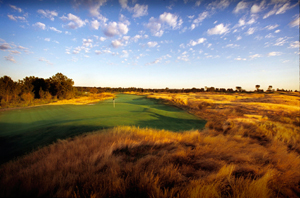Featured Golf News
An Inside Look at Liberty National
You are going to see and hear a lot about Liberty National Golf Course over the next few days and weeks. But if there is one thing that sticks in your mind it should be this: the quality of golf and the demand for great shots truly rivals the stunning vistas from this Jersey City, N.J., course on the Hudson River.

The 2nd Hole at Liberty National
(Photo by Joann Dost and Evan Schiller)
And that's saying something, given that parts of Liberty National are only about 1,000 yards from the Statue of Liberty, and that every corner of the track features panoramas of the famed Manhattan skyline and Lady Liberty.
By now you've likely heard the story of how Liberty National was created on land that used to be a Superfund toxic dump, with the vision and design skills of co-architects Tom Kite (the 1992 U.S. Open champ and former Ryder Cup captain) and Bob Cupp turning trash - literally tons of it - into treasure.
This week the best players on the PGA Tour are getting their first real look as Liberty National as they prepare for The Barclays, the first tournament of the FedEx Cop Playoffs. In advance - and in some cases with - those players, I was able to tour the course with Kite, who was as excited and proud as an expectant father on the eve of the birth of a child.
"We are excited that PGA Tour players will get to test Liberty National under the pressure of tournament and playoff conditions," Kite said. "Perhaps even more so, it is a thrill to know that, with this television special and the week of competition on the course, will allow the public to experience what was created at Liberty National. It is an unveiling in many ways."
Playing at up to 7,419 yards from the tips, Liberty National seems tight, its 18-holes, driving range, short-game facility and massive clubhouse squeezed onto just 160 acres. But after being on the course and playing it, one understands there is plenty of room in the fairway - it's the space outside the short grass that might make a golfer pucker on the tee box.
Liberty National features a combination of classic tree-lined holes and Scottish-style links. About 4,000 feet of the property is on the waterfront, which encroaches on three sides. The Statue of Liberty looms in the distance, so close at times you feel you can reach out and grab her.
But the course itself demands your attention, as many of the Tour players found out during practice rounds.
After opening the round with a relatively benign dogleg-right par-4 away from the river and over a creek, you sit up and remember just where you are on the 219-yard par-3 second. The tee shot is directly toward Lady Liberty, and with the left cup placement it almost seems as if she is tending the pin for you. A long bunker guards the entire left side of the green, while a pot bunker right and another trap deep provide quite a difficult target.
No. 3 is a hole that was much discussed during the setup of Liberty National for The Barclays. Listed at 402 yards on the scorecard, officials mulled over moving up the tees as much as 35 yards to narrow the landing area and bring into play the deep fescue that lines both sides of the fairway and the deep bunker on the right. The green - the smallest on the course - slopes downhill and then back uphill and is surrounded by rises and deep hollows.

Liberty National's 5th Hole
(Photo by Joann Dost and Evan Schiller)
The fifth demands pinpoint accuracy off an elevated tee. Playing as long as 442 yards with a lake guarding the left, and mounding and trees on the right, at the landing area, a small creek winds green-ward and past the putting surface. No. 5 is the first of Liberty National GC's real testers, so there are plenty more ahead.
The beauty of the 548-yard par-5 sixth is its risk-reward opportunities. Playing slightly downhill, the landing area is inviting off the tee, setting up a chance to get home in two. The lay-up area, in contrast, is very tight but will leave a simple pitch to the very long green. One must be aware of a huge pond front-right of the green, which is perched just beyond a rock wall and a pesky pot bunker.
The front side at Liberty National finishes with its strongest triad of holes. First there is the 484-yard par-4 seventh, which requires a great shot over the water and has three bunkers on each side of a pinched landing area. Another huge bunker lurks to the right of the very shallow green.
No. 8 - at 611 yards - is the longest hole at Liberty National. A drive hit too well off from the elevated tee will reach a 100-yard long patch of high grass that sits in the middle of the fairway, creating a shot that might not be executed well enough to secure par. The green slopes from back to front and is very slick.
The ninth is a 474-yard par-4, which plays downhill over a lake, but short of the creek that crosses the hole about 150 yards from the green. The approach is slightly uphill, with two pot bunkers left and a chipping area right. Don't be fooled by the fore-bunker that sits right and well short of the putting surface.

Liberty National's 17th
(Photo by Joann Dost and Evan Schiller)
No. 10 is a 496-yard par-4. Even with a big shot off the tee, a long-iron or more is needed for the approach to a green that is the biggest on the course. Liberty National's length continues at the 250-yard par-3 11th, which five small collection areas for long or right tee shots.
The 12th features a split fairway - which is attacked will be determined by where the cup is set. No. 13 was designed as a reachable par-5, but at 563 yards and often into the wind coming from the direction of the Verrazano Narrows Bridge watch for a devious front-right pin placement that could tempt players to hit to that side but instead find either the bunker right-rear or the hidden depression behind the putting surface.
Of all the "wow-factor" holes at Liberty National GC, and there are plenty, the 14th may be the most stunning. At the tee of this 150-yard par-3, you walk directly toward the Statue of Liberty, her robes seemingly close enough to reach out and touch. One must gather focus to find the green at this tiny beauty, guarded left by a deep pot bunker, right by a string of sand and rear by tall grass and an inlet of New York Bay.
The 481-yard 15th brings reality back into focus with its narrow fairway, three bunkers right of the landing area and an amphitheater-type area around the green. You might get a shot (or even two) back on the 324-yard par-4 16th, which could play considerably shorter (maybe even as little as 295 yards) during The Barclays. Tournament officials want the players to try to go for the green off the tee, but a shot to the right brings a pond and waterfall into play and anything left will be snatched by a huge bunker.
No. 17 eases back toward to bay, but at 445 yards and with a headwind, par might be good enough in the final round to secure The Barclays title. Same goes for the 508-yard finisher, a real test into the wind that rises some 30 feet uphill toward Liberty National's gleaming $60 million clubhouse. The panorama here is sublime, with the New York City skyline in the background and Lady Liberty just off to the right.
There is no doubt that Liberty National has to be put on the short list of best courses in America, no matter how the Tour pros do at The Barclays. After a round here, one feels exhilaration and exasperation as well as a great feeling of patriotism and respect for the views of the Big Apple and its neighbors in New Jersey.
There's no place quite like Liberty National.
Steve Habel is one of Cybergolf's national correspondents, contributing news stories, features, equipment and book reviews and personality profiles from his base in Central Texas. He is also the media coordinator for Bechtol Golf Design, the managing editor for Business District magazine in Austin and works as a contributing editor for Horns Illustrated magazine, a publication focusing on University of Texas sports. He also writes a blog (www.shotoverthegreen.blogspot.com), which features news on golf and the Longhorns.
Story Options
 |
Print this Story |
